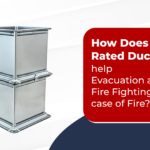What is the Difference Between Fire Rated Ducts and Regular Ducts?
In any HVAC system, ductwork plays an essential role in circulating air throughout a building. However, not all ducts are created equal—especially when it comes to safety during a fire. The key difference between Fire Rated Ducts and Regular Ducts lies in their ability to withstand high temperatures and prevent the spread of smoke and flames. Fire-rated ducts are specifically engineered for critical situations where time, safety, and containment matter most. Understanding these differences is vital for architects, engineers, contractors, and building owners focused on fire safety, regulatory compliance, and overall system performance.
1. Fire Resistance and Heat Tolerance
Fire rated ducts are designed and tested to withstand extreme heat, typically for up to 120 minutes or more, without collapsing or allowing fire to spread. These ducts are constructed using fire-resistant materials and insulation that prevent the transfer of heat and smoke. In contrast, regular ducts are meant for daily air circulation and do not have the structural strength or insulation to survive during a fire. They can fail quickly, allowing smoke and flames to move through the building.
2. Purpose and Application
Fire rated ducts are used specifically in critical life safety applications, such as smoke extraction systems, pressurization systems, and kitchen exhausts. Their role is to maintain airflow and isolate fire-affected areas during an emergency. Regular ducts are used for standard ventilation, heating, and cooling, where fire safety is not the primary concern. They serve general HVAC functions without any fire-resistant properties.
3. Types and Testing Standards
Fire-rated ducts are available in coated and non-coated steel. The critical factor is that any system, regardless of its type, must be rigorously tested and certified to meet stringent criteria. Testing and certification must adhere to the time-temperature curve, rather than being limited to specific temperatures like 400°C or 600°C.
The time-temperature curve (Figure 1), defined by standards like ISO 834, represents the heat progression in a furnace during fire testing. For example, at 60 minutes, the temperature reaches approximately 925°C, and at 2 hours, it reaches 1049°C. Standards like BS476-24 and EN1366-8, 9 follow this curve for fire-rated duct testing. Therefore, full-temperature curve testing is essential for a product to be recognized as fire-rated.
4. Applications and Performance Criteria
Fire-rated ducts are indispensable in critical applications such as mechanical ventilation, smoke extraction, staircase pressurization, make-up air ducts, and kitchen extract ducts. These applications require fire-rated ductwork to prevent secondary fires and ensure breathable air during evacuation, even when ducts traverse multiple fire zones.
The potential risks of flashovers, uncontrollable secondary fires, and loss of life and property far outweigh the marginal cost increase associated with insulated ducts. Every investment in fire safety yields a substantial return in safeguarding lives and property.
Performance criteria for fire-rated ductwork, as defined by BS and EN standards, include stability, integrity, insulation, cross-section, and kitchen duct specific requirements. Tests must be conducted under two scenarios: fire outside the duct (Duct A) and fire inside and outside the duct (Duct B).
- Stability: Ducts must remain intact and stable across supports, without collapsing.
- Integrity: No fire or flame leakage should occur inside or outside the ducts, including wall penetration seals.
- Insulation: Surface temperatures of duct insulation must remain below 140°C on average and 180°C at any specific point above ambient temperature.
- Cross-Section: For smoke extraction, 75% of the cross-section must be maintained during testing.
- Kitchen Duct: The duct must withstand external fire while maintaining internal temperatures below 140°C on average and 180°C at any specific point.
5. Key Considerations for Specifiers
When evaluating fire-rated ductwork, consultants should ask critical questions:
- Is the duct tested to the full time-temperature curve?
- Are all criteria met for both Duct A and Duct B?
- Are integrity, stability, and insulation ratings adequate?
- Are Test Certificates verified? (Test Certificate must be issued by an accredited certifying body)
- For Smoke and kitchen extract, has the duct been tested with insulation as a system?
For smoke extract, is the smoke extraction criteria mentioned in the test certificate?



